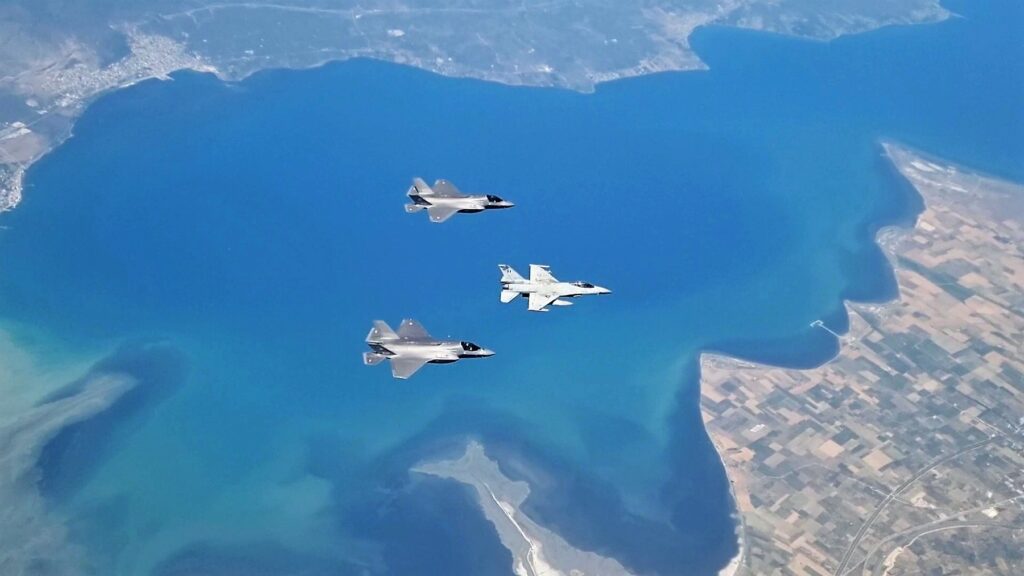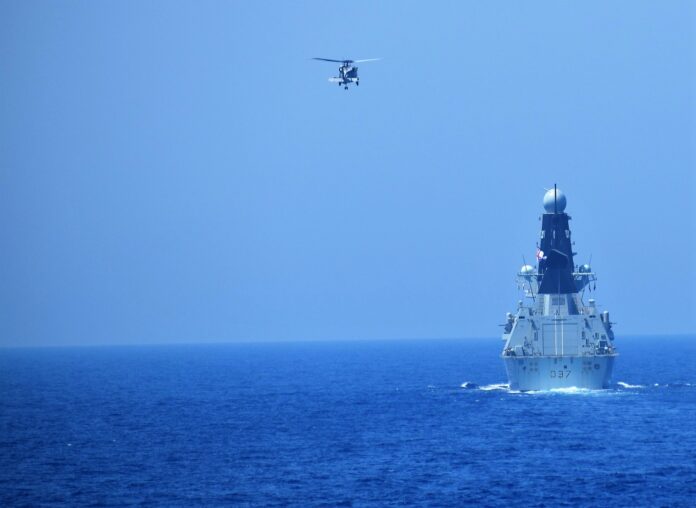
Greek and Turkish naval and air forces participated in a NATO exercise that took place last week in the Mediterranean.
The Neptune Strike 23-2 exercise involved fighter jets from three different nations and was commanded from Standing NATO Maritime Group 2 (SNMG2) flagship HMS Duncan.
NATO says that four ships from Greece, Turkey and the UK seamlessly integrated into a defensive multi-national NATO force, whilst the fighter jets fulfilled the roles of both friendly and hostile forces.
This created a realistic and challenging operational scenario for the task group. The combined force of fighter jets included Hellenic Air Force F16s, Turkish Air Force F16s, and Royal Air Force Typhoons, whilst a Royal Air Force Voyager provided air-to-air refuelling.
The exercise enabled the task group, and its multi-national staff, to test their tactics, techniques and procedures in the provision of integrated air-defence and anti-air warfare.
Greek and Turkish frigates participate in the same NATO exercise

The Hellenic frigate HS Limnos, the Turkish frigates TCG Gokceada and TCG Goksu, and HMS Duncan (a British Royal Navy destroyer) were able to demonstrate their capability and interoperability, proving they are ready to defend themselves and the task group from real-world airborne threats.
The Commander of SNMG2, Royal Navy Commodore Paul Stroude, said, “bringing this number of military assets together to operate seamlessly is an impressive demonstration of the strength that comes from combining individual national capabilities into a far greater, integrated, and effective, multi-national force.”
The air defence exercise was part of a larger period of NATO-led vigilance activity, known as Neptune Strike. It is led by Naval Striking and Support Forces NATO (STRIKFORNATO), which is a deployable and scalable headquarters designed to command high-end strike capabilities such as aircraft carriers and amphibious task groups.
Neptune Strike focuses on the ability to integrate such task groups into a dynamic, flexible NATO command structure.
During the exercise, the US Navy aircraft carrier USS Gerald R. Ford and the Italian aircraft carrier ITS Garibaldi were brought under NATO command.
Escorting and protecting ships such as these is one of the core tasks of SNMG2, hence for Neptune Strike 23-2 the anti-submarine warfare frigates ITS Carabiniere and FS Languedoc were detached from SNMG2, to form part of the defensive shield surrounding the two aircraft carriers.
Thaw in relations between Greece and Turkey
The participation of Greek and Turkish forces in such a highly complex exercise is an indication of a thaw in relations between the two NATO allies.
Last week a rare meeting between the Prime Minister of Greece Kyriakos Mitsotakis and the President of Turkey Recep Tayyip Erdogan was held on the margins of the NATO Summit in Vilnius, Lithuania.
The two leaders agreed that the positive climate in the bilateral relations in recent months should have both “continuity and consistency” as this would be in the interests of the two countries.
It was agreed that both sides should build on the positive momentum and activate multiple channels of communication between the two countries in the near future.
See all the latest news from Greece and the world at Greekreporter.com. Contact our newsroom to report an update or send your story, photos and videos. Follow GR on Google News and subscribe here to our daily email!



